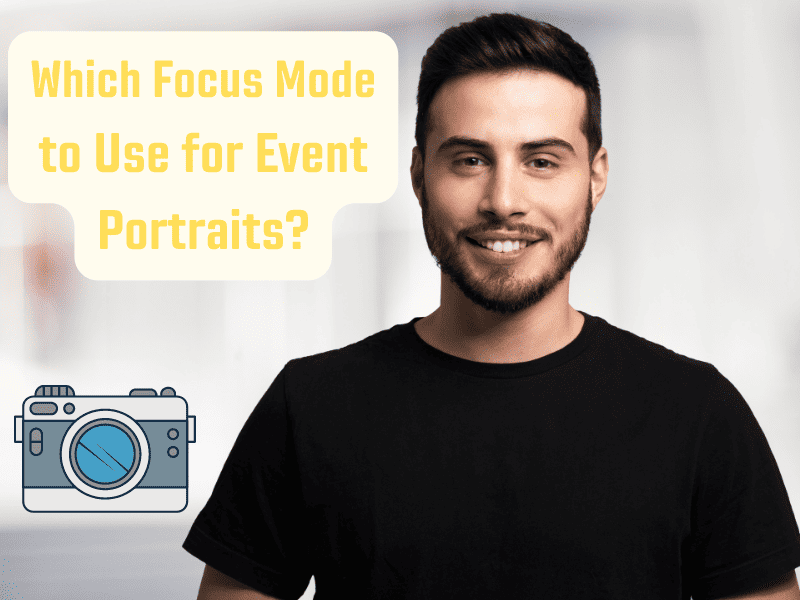Capturing stunning portraits at events requires a keen eye for composition and an understanding of your camera’s settings.
One of the most important aspects of portrait photography is the focus, and choosing the right focus mode is essential to achieving sharp, well-defined images. In this article, we will explore different focus modes available on most cameras and provide recommendations on which modes to use for portraits at events.
If you’re a beginner photographer looking to take some event portrait photos, this guide will help you achieve stunning, high-quality images.
Table of Contents
Recommend Focus Modes: Single/Group Autofocus Point(s)
For portraits at an event, it is recommended to use a single autofocus point or a small group of autofocus points. This will ensure that the subject’s face is in sharp focus while the background is slightly blurred. Known as a shallow depth of field, this image effect is desirable for portraits. Additionally, you should use a wide aperture (such as f/1.8 or f/2). This will make the subject stand out in the image and draw attention to them.
A single or small group of autofocus points is a great way to achieve sharp, well-defined portraits at events. Here are a few reasons why:
- Precision: By using a single autofocus point, you can ensure that the focus is precisely on the subject’s face. This is especially important when capturing portraits because you want the subject to be in sharp focus while the background is slightly blurred.
- Control: Using a single autofocus point gives you more control over where the camera focuses. This allows you to ensure that the subject’s face is in sharp focus rather than an unintended background element.
- Consistency: Using a single autofocus point can help to ensure consistency in your images. It can be difficult to achieve consistent focus using automatic area focus or continuous autofocus if you’re capturing a series of portraits.
- Predictive Focus: In some cameras, the single autofocus point mode can also allow you to track the subject and predict their movement, ensuring that you always focus on the subject even if they move.
- Avoid distractions: By using a single autofocus point, you can avoid the camera focusing on unwanted elements in the background, which can be distracting and detract from the overall image.
It is important to note that using a single autofocus point may require more skill and practice, but it can be a powerful tool for achieving sharp, well-defined portraits at events. Additionally, it is important to check your camera’s manual or online resources to understand how to set and use the single or small group of autofocus points in your camera.
Other Focus Modes
Continuous Autofocus (AF-C)
Continuous autofocus (AF-C) is designed to track moving subjects and keep them focused as they move. This mode is unsuited for portraits because the subject is typically not moving, and the focus point may inadvertently shift to a background element.
Automatic area focus (AF-A)
Automatic area focus (AF-A) allows the camera to select the focus point based on the scene in front of the lens. While this mode can be useful in some situations, it can also lead to unexpected focus points, such as the background or a nearby object, instead of the subject’s face.
Manual Focus (MF)
Manual Focus mode can be a good option for portraits at events in certain situations where a high degree of control over focus is needed, but it can be more time-consuming and require more skill to use effectively. In most situations, single-point autofocus or a small group of autofocus points will be sufficient for event portrait photography.
Shutter Speed for Portrait Photography
You typically want to use fast shutter speed settings when taking portrait photos. If you’re holding the camera, Iceland Photo Tours recommends a 1/200th of a second speed for daytime/without flash photos. However, you can decrease the speed down to 1/15th if you’re using a tripod.
A slower shutter speed can cause motion blur in your photos, which can be particularly problematic when taking portrait photos. If your subject moves even slightly while the shutter is open, this movement will be captured in the final image, resulting in a blurred or smeared image. Additionally, if you are handholding your camera and using a slow shutter speed, a camera shake can cause blur, even if your subject is perfectly still.
Lighting for Great Event-Portrait Photos
Use natural light when possible: Natural light can create a soft and flattering look for your subjects. Look for soft, diffused light areas, such as open shade or a window with sheer curtains. Using a flash or other artificial lighting can help to illuminate the subject’s face and fill in any shadows. This can be especially helpful when the event is in a dimly lit location.
Remember that lighting is an essential element of portrait photography, and it’s important to take the time to experiment and learn how to use different lighting techniques to create the best possible images. The more you practice, the more comfortable you will become with different lighting setups, and the more you will be able to adapt to any situation and get that perfect shot!
Conclusion
In conclusion, the best focus modes for portraits at an event are single and group autofocus point(s). However, there may be specific cases where you want to use the manual focus mode. Ensure you have good lighting, as bad lighting will ruin an otherwise good photo.
One last tip: Photograph everyone you are asked to take a picture of. Don’t miss anyone. This ensures that no one is left out and that all the guests can be included in the memories. You don’t want the reputation of a photographer who missed a guest!
